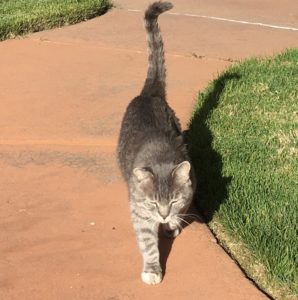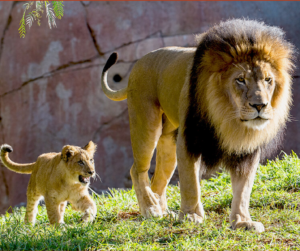Your cat’s tail helps him balance when he is running, jumping and doing the high wire walk on the fence railing. Your cat’s tail can also tell you a lot about his mood. Is it gently swishing side to side? Flicking back and forth rapidly? Puffed up with the fur standing on end?
With some cats the tail is always in motion, unless they are asleep. Gentle swishing side to side may indicate your cat is attentive and focused on something. The tail starts flicking back and forth rapidly when your cat has sighted prey or is getting ready to pounce, on a mouse, toy or another cat. This may not be the best time to snuggle!
Of course, when the tail is puffed up like a Halloween cat, owner beware! It may be that your cat or kitten was startled by something, is fearful or ready to go on the warpath! Take care when handling her.

You may see a cat hold his tail up, almost vertical. Sometimes there may be a little hook at the end or the tail might droop over his back toward his head.
Why my cat holds his tail up…
This posture, called “tail up”, may just indicate that a cat is confident and happy. However, “tail up” also gives cats a way of signaling each other that they are friendly and don’t want to fight. Cats being solitary hunters want to avoid fighting and injury. If they are injured, they will have difficulty hunting and may starve.
Using “Tail Up”to Communicate
- When a cat approaches another cat with his tail up, he is signaling the second cat that he has friendly intentions. Let’s say that the other cat holds his tail up in response. If the two cats are members of the same social group, they may then proceed to touch noses or rub up against each other.
- If the second cat does not respond with a “tail up,” the interaction may end.
- Cats often approach humans with a tail up. Community cats will acknowledge their human care takers with “tail up” at feeding time. Owned cats acknowledge their owners as part of their social group with a “tail up”, often followed by a head rub.
- The “tail up” signal may also indicate some social ranking in the cat colony – a cat holds his tail up when approaching another cat with a higher social standing.
Where does tail up come from?
We will probably never know exactly how the tail up signal originated. We do know that kittens approach their mother with their tails up and often rub against her chin, perhaps soliciting food. Kittens will also approach other adult cats with their tails up, discouraging an unfriendly response. Kittens most likely learn the tail up signal from their mothers.

That other social cat…
Interestingly enough, tail up is also a greeting behavior shown by the other social cat, the lion. Both domestic cats and lions form social groups clustered around a core of related females. The lion and domestic cat both belong to the family felidae but are members of different genera -the lion belongs to the Panthera, the cats that roar; our cats belong the genus Felis, the cats that purr. Most likely, the “tail up” signal evolved separately in each species in response to similar social pressures.
The domestic cat forms social groups when there is plenty of food available. Over the centuries, cats have developed the “tail up” signal to let other cats know that they are friendly and do not wish to fight.



3 thoughts on “Why my cat holds his tail up”